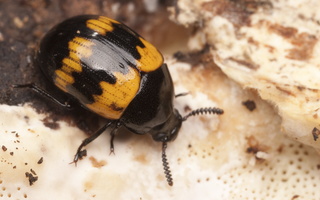- sort orderDefault
Photo title, A → Z
Photo title, Z → A
✔ Date created, new → old
Date created, old → new
Date posted, new → old
Date posted, old → new
Visits, high → low
Random - Google Map
- map
 home / Insecta · vabzdžiai / Coleoptera · vabalai / Tenebrionidae · juodvabaliai / Diaperis boleti · raštuotasis juodvabalis
home / Insecta · vabzdžiai / Coleoptera · vabalai / Tenebrionidae · juodvabaliai / Diaperis boleti · raštuotasis juodvabalis

Diaperis boleti · raštuotasis juodvabalis
- Gelbbindiger Schwarzkäfer
- raštuotasis juodvabalis
- piepju melnulis
- boletenzwartlijf, boletenzwartlijfkever, boomzwamzwartlijfkever
- borzewka
ukbeetles.co.uk/diaperis-boleti
This species occurs sporadically throughout Europe except in far northern areas, extending to northwest Africa, the Middle East and through Siberia to the far east of Asia. The typical habitat is old established broadleaf woodland with plenty of trees in various stages of decay but it may also occur on isolated old trees in parkland or gardens etc. Adults are nocturnal and generally occur on various host fungi, particularly Laetiporus sulphureus, Piptoporus betulinus, Fomitopsis pinicola, Fomes fomentarius, Polyporus squamosus. They feed on the fruiting bodies and may be detected by the large tunnels they leave as they do so.
The entire life cycle occurs on the host fungi; adults mate in the spring and eggs are laid in the fungal tissue, larvae quickly emerge and feed on the host; they are pale and cylindrical with well developed legs and a dark head with prominent mandibles, development is rapid and when fully grown they construct a pupal cell within the host and new generation adults occur from early summer. Oviposition occurs over a long period as we have found teneral adults through the summer, they disperse nocturnally by flight and, as the host may only persist for a single season, new host material must be found each year although they are able to use dry remains of old fruiting bodies and will occur among dead wood and loose bark long after the fungus has decayed and vanished. New host material is quickly colonized and adults tend to occur in numbers, sometimes dozens crammed tightly under the fungus and among surrounding bark, and they persist until the host decays or becomes damaged. There is a single generation each year, adults overwinter among bark or dead fungi.





